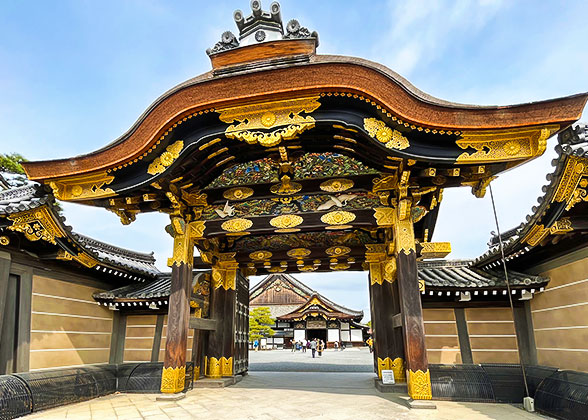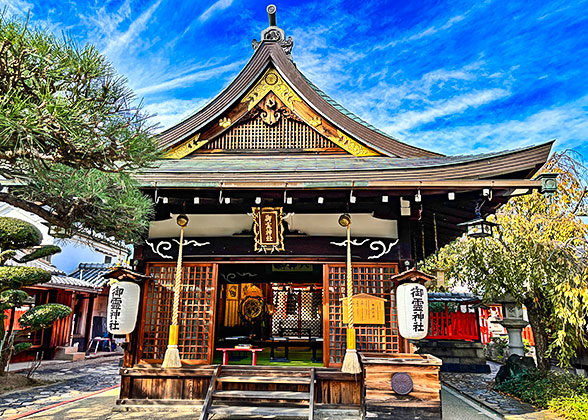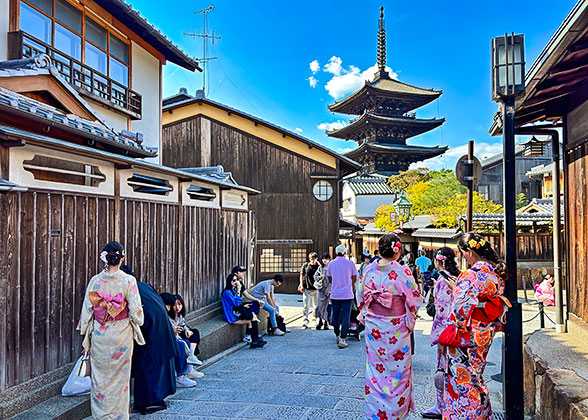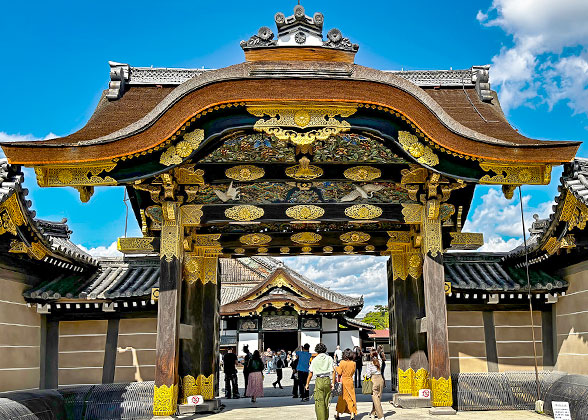Nijo Castle
Nijo Castle is the only palace complex among all the 17 UNESCO World Heritage Sites in Kyoto, the ancient capital of Japan. Constructed in 1603, the Castle was used by Tokugawa Ieyasu (r. 1603-1605), the then shogun or military leader, as a token of his supreme power, though nominally a fortification and temporary office to serve the Japanese Emperor. Here, you can find paintings, sculptural art, and architecture of the Azuchi-Momoyama period (1568-1600).
Nijo Castle, Important Witness to History
Nijo Castle witnessed the rise and fall of Tokugawa Shogunate, the de facto ruling power of Japan over the emperors during the Edo period (1603 - 1868), an era of peace, cultural diversity, and economic boom. Tokugawa Ieyasu, founder of the Tokugawa Shogunate, was the one that took over the country from his archenemy the Toyotomi family, unified the then divided Japan, and established his military government. And it’s in Nijo Castle, built by Ieyasu, that he showed his superiority over the Toyotomi family and even Emperor Go-Mizunoo (r. 1611-1629)You May Like

Nijo Castle Photos ( 27
|
Highlights of Nijo Castle
Nijo Castle is mainly composed of two compounds, one centering upon the Ninomaru-goten Palace with the Ninomaru Garden and another upon the moated Honmaru-goten Palace. A bridge leads one to another. The following are the highlights of Nijo Castle worth your while.
|
|
|
The Karamon Gate, the grand entrance
The Karamon Gate is the main entrance to the Ninomaru-goten Palace. Don’t just go past it. Take time to appreciate its architecture, which features a curved gable roof (karahafu, a typical Japanese-style roof), cypress shingles, and carved gold leaf in the image of chrysanthemum. The gate itself already speaks for Ieyasu’s ambition, as the chrysanthemum is a symbol of Japan’s royal family.

Karamon Gate, the grand entrance
|
The Ninomaru-goten Palace, the largest complex of Nijo Castle
The Ninomaru-goten Palace is where the ceremony was held for the imperial house of Japan to restore power from the Tokugawa family in 1867. The whole structure is made up of five separate but interconnected buildings, stretching from southeast to northwest in a diagonal fashion. What make it extraordinary are its 33 rooms decorated with some 3,000 replica traditional paintings and over 900 originals. There are images of pine forests, eagles, tigers and so on serving to suggest the Tokugawa family’s majesty, as well as cherry blossoms, painted by the Kano school, which primarily serves aristocratic class and is famous for its bold art style.Fascinatingly, although the first several buildings were to intimidatingly impress people with paintings of fierce beings, the Tokugawa family created a quite different space in the last that enjoys calming ink paintings and was possibly their living quarter. Subjects of the ink paintings, like China’s West Lake, offers insight into a historical period when Japan borrowed Chinese culture for their own use out of admiration.

The first building of Ninomaru-goten Palace
|
Ninomaru Garden, a beautiful garden for the Emperor
To the west of the Ninomaru-goten Palace lies the Ninomaru Garden, whose charming waterscape has earned it the title of Special Scenic Beauty Site of Japan. Everything in the garden - the winding glassy water body, rock formations, islets, and a three-tiered cascade - was a result of elaborate design, with strong Chinese influences. After all, it was built for Emperor Go-Mizunoo to appreciate.

The classical Ninomaru Garden
|
The Honmaru-goten Palace, temporary imperial palace once destroyed by fire
The Honmaru-goten Palace is another primary building of Nijo Castle across the bridge to the west of Ninomaru. Like Ninomaru Garden, this palace was also built to serve the visit of Emperor Go-Mizunoo. Originally as large as the Ninomaru, its present smaller scale was a consequence of a fire in 1788. It had been rebuilt during the late Edo period, but as a symbol of feudal power, it was destroyed again in the Meiji period in 1881.
|
|
|
The Base of the Keep Tower
At the left bottom of the Honmaru compound there was a Keep Tower, a five-storey relocated by the third shogun Tokugawa Iemitsu from the former residence of the Toyotomi family. Demolished by a lightning bolt in 1750, it has little left, but you can climb the surviving steps to have a panoramic view of the enclosure and streets of Kyoto.

Honmaru-goten Palace seen from a distance
|
Gallery
If you’d like to examine the original paintings from the Ninomaru-goten Palace, the Gallery at the eastern border area of Nijo Castle provides a chance. Please note that you need to purchase a ticket to enter.
Know Before Going
Opening hours: 8:45 am to 5:00 pmClosing days of Nijo Castle: Dec. 29 - 31
Closing days of the Ninomaru-goten Palace: Tuesdays of January, July, August, and December; Dec. 26 – 28; Jan. 1 - 3. Closed the next day if the mentioned days falls on a national holiday.
Admission fee: 1,300 yen

Official map: structure of Nijo Caslte and recommended route
|
How to Get There from Kyoto Station?

Bus stop
|
By bus (20 minutes):
Take Kyoto City Bus No. 9/No. 50, get off at Nijojo-mae station, and walk 1 minute.By train (15 minutes):
Take Subway Karasuma line to Karasuma-Oike Station, change to Subway Tozai line, get off at Nijojo-mae station, and walk 1 minute.
Nearby Attractions
Kyoto Imperial Palace was the living quarter and office of the Japanese emperors - who the Tokugawa family “served” - until the end of the Edo period. It was constructed the time Kyoto become the capital of Japan 1,200 years ago.
Nishiki Market, acclaimed as “Kitchen of Kyoto”, is a snack street selling various novel or traditional local-flavored Japanese food, with free samples as a big feature. It’s near Kyoto’s liveliest historic area, Gion. Shops here usually close one following another from 4 pm, so it's suggested visitors place it as a priority for a day's trip.
Nijo Castle Photos & Video






